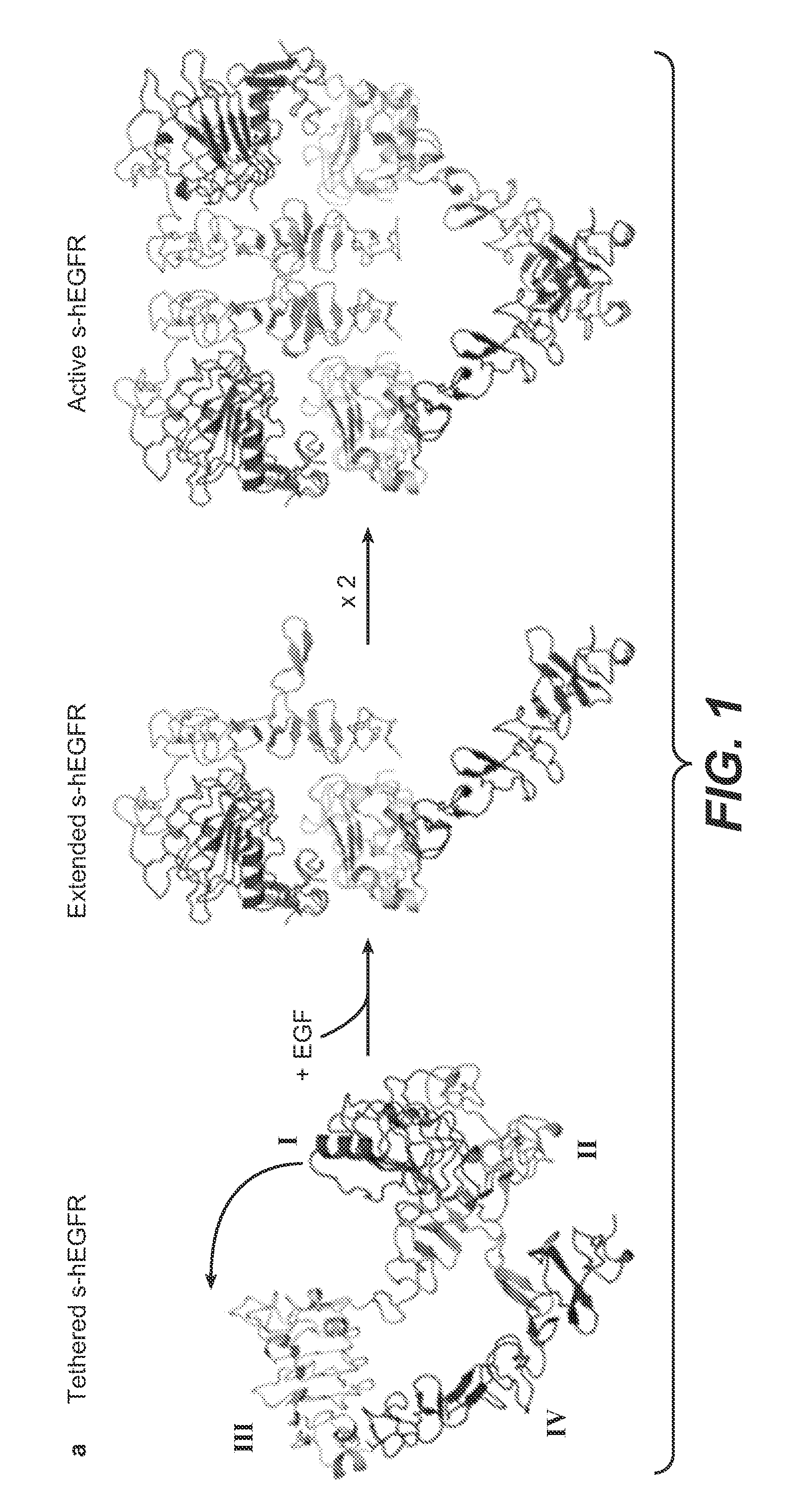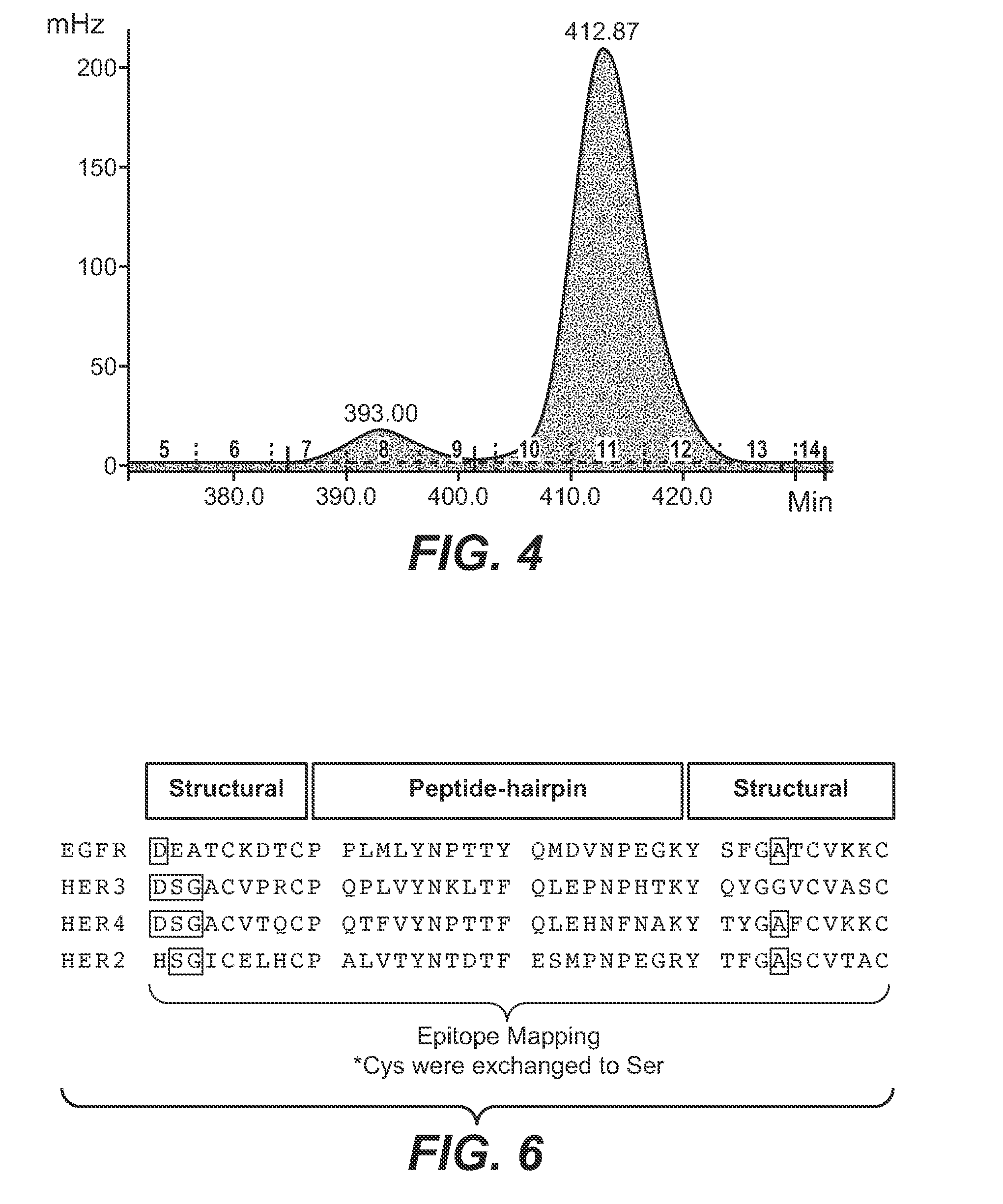Her1 antigen binding proteins binding to the beta-hairpin of her1
a technology of antigen binding proteins and her1 beta-hairpins, which is applied in the field of antiher1 antigen binding proteins, can solve the problems of harmful hypersensitivity reactions, induction of immune responses, and non-human monoclonal antibodies (e.g., murine monoclonal antibodies) lacking human effector functionality, and achieves less side effects and high value. the effect of valuable properties
- Summary
- Abstract
- Description
- Claims
- Application Information
AI Technical Summary
Benefits of technology
Problems solved by technology
Method used
Image
Examples
example 1
Preparation of Antigen and Screening Proteins
Generation of Functional β-Hairpin HER1 Constructs for Selecting Antibodies Binding to the β-Hairpin of HER1
[0422]To generate functional β-Hairpin HER1 constructs, the amino acid sequences of the HER1 β-HairpinHER1, was grafted into a SlyD polypeptide framework comprising a FKBP domain. In such constructs the grafted β-Hairpins are freely accessible in contrast to the hidden structure in the native unactivated conformation of HER1 (in the absence of ligand as e.g. EGF) (see FIGS. 1 and 2, where the β-Hairpin of HER1 is hidden).
[0423]All fused SlyD polypeptides can be purified and refolded by using almost identical protocols. E. coli BL21 (DE3) cells transformed with the particular expression plasmid were grown at 37° C. in LB medium containing the respective antibiotic for selective growth (Kanamycin 30 μg / ml, or Ampicillin (100 μg / ml)) to an OD600 of 1.5, and cytosolic overexpression was induced by adding 1 mM isopropyl-β-D-thiogalactosi...
example 2
a) Immunisation and Selection of HER1 Antibodies
[0424]For the generation of antibodies against the β-hairpin of HER1, Balb / C, NMRI or SJL mice were immunized with different antigens. As antigens the following proteins were used: full length HER1 ECD, or the epitope scaffold proteins TtSlyDcas-HER1, TtSlyDcys-HER1 and TtSlyD(GSG)-HER1. The TtSlyDcas-HER1 variant represents the first generation epitope scaffold, used for generation of HER1 dimerization domain specific antibodies.
[0425]All mice were subjected to 3 immunizations at the time points 0, 6 and 10 weeks after start of the immunization campaign. At each time point each mouse was immunized with 100 μg endotoxin free immunogen dissolved in 100 μl PBS. For the first immunization the immunogen was mixed with 100 μl CFA. For the second and third immunization the immunogen was mixed with IFA. The first and the third immunization were applied via the intraperitoneal route, the second immunization was applied subcutaneously. 2 and 3 ...
example 3
Exemplary Epitope Mapping of an Anti-HER1 Antibody (M-47-13) Peptide-Based 2D Epitope Mapping
[0433]In another embodiment a peptide-based epitope mapping experiment was done to characterize the HER1 ECD epitopes by using the CelluSpots™ Synthesis and Epitope Mapping technology. Epitope mappings were carried out by means of a library of overlapping, immobilized peptide fragments (length: 15 amino acids) corresponding to the sequences of human HER1 ECD, HER2 ECD, HER3 ECD and HER4 ECD peptide hairpins. In FIG. 6, the strategy of the epitope mapping is shown. The peptide hairpin sequences (β-hairpin) of HER1(EGFR) ECD, HER2 ECD, HER3 ECD and HER4 ECD including their structural embeddings (structural) were investigated. Cysteins were replaced by serines. Each peptide synthesized was shifted by one amino acid, i.e. it had 14 amino acids overlap with the previous and the following peptide, respectively. For preparation of the peptide arrays the Intavis CelluSpots™ technology was employed. ...
PUM
| Property | Measurement | Unit |
|---|---|---|
| concentration | aaaaa | aaaaa |
| length | aaaaa | aaaaa |
| nucleic acid | aaaaa | aaaaa |
Abstract
Description
Claims
Application Information
 Login to View More
Login to View More - R&D
- Intellectual Property
- Life Sciences
- Materials
- Tech Scout
- Unparalleled Data Quality
- Higher Quality Content
- 60% Fewer Hallucinations
Browse by: Latest US Patents, China's latest patents, Technical Efficacy Thesaurus, Application Domain, Technology Topic, Popular Technical Reports.
© 2025 PatSnap. All rights reserved.Legal|Privacy policy|Modern Slavery Act Transparency Statement|Sitemap|About US| Contact US: help@patsnap.com



